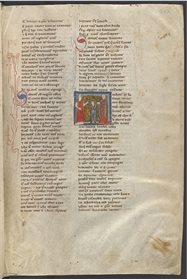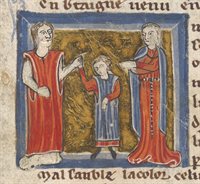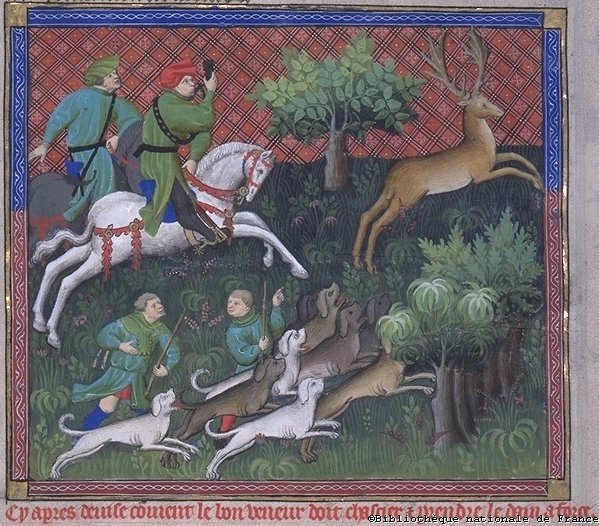[This post was written in the spring 2018 semester for Karrie Fuller's course on Chaucer’s Canterbury Tales. It responds to the prompt posted here.]
Over the years, Taylor Swift has forged an empire, and by doing so, she has become one of the most talked about women in the entertainment industry. From her seemingly endless love affairs to her Grammy nominated albums, the number of headlines she has appeared on have made her a household name across the globe. Through her fame, Swift has been demonized for the decisions she has made in her love life and has been heroicized for the actions she has taken to connect with her fans. If one looks back to the Middle Ages, they will realize there is another famous woman that also tends to carry with her much inspiration and controversy. The Wife of Bath from Geoffrey Chaucer’s The Canterbury Tales is quite possibly the most well-known character of the entire work. Her fame amongst scholars and students stems from her remarks on proto-feminist ideals and also from her abrasive and expensive nature. Her character wants to be known, just as Taylor Swift does. Both of these women have attracted widespread attention, and while there is close to 600 years separating them, they have a great deal in common. This blog post will go on to reveal the similarities that the Wife of Bath and Taylor Swift share in order to showcase the timelessness of having a strong female presence in society, and how this presence has the ability to spark radical conversation and eventual change in gender dynamics.
Look What You Made Me Do
“The wo that in myn herte was, and pyne?
And whan I saugh he wolde nevere fyne
To reden on this cursed book al nyght,
Al sodeynly thre leves have I plyght
Out of his book, right as he radde, and eke
I with my fest so took hym on the cheke
That in oure fyr he fil bakward adoun.” (lines 787-793).
In this excerpt from the Wife of Bath’s Prologue, we learn of a time when one of her previous husbands, whom she loved and trusted, wronged her. After constantly being read books about the problems that her husband believes can arise when wives are not obedient to their husband’s demands, the Wife of Bath finally releases her frustration by attacking her spouse. This quote places the blame for the assault on the husband, not on the Wife. In Taylor Swift’s, Look What You Made Me Do music video, something similar can be seen. In the video, Swift references specific moments from her professional career and, in turn, passively calls out particular individuals that affected her negatively along the way. Basically, Swift is telling her haters that it is their fault she had to write and release this song.
No matter which side you’re on: the Wife of Bath or her husband’s, Taylor Swift’s or Kanye West’s; it’s hard to ignore the call to choose a superior. It’s in our nature, and both Swift and the Wife of Bath are aware of this instinct. They use it to their advantage. After all, all publicity is good publicity when it comes to building a following and without an audience, it is impossible to have any true voice in the world now or back in the Middle Ages.
Glitz and Glam
“Hir coverchiefs ful fyne were of ground
I dorste swere they weyden ten pound
That on a Sonday were upon hir heed.
Hir hosen weren of fyn scarlet reed
Ful streite yteyd and shoes ful moyste and newe,” (lines 453-457).
The Wife of Bath certainly knew how to ‘knock em dead’ with her looks, or at least with her sense of fashion. She is not a shy character, so we shouldn’t expect her closet to be either. It was her goal to stand out and look the part, and with her “scarlet reed” hose, she surely made an entrance. Red is a very vibrant and sensual color, and the Wife of Bath is a very sexual individual. It is no wonder that she would be wearing something as daring as red pantyhose beneath her skirt. Part of Taylor Swift’s fame stems from her image and fashion just as it does with the Wife of Bath. When attending public events, Taylor’s outfits always get mentioned in the next day’s ‘hot or not’ gossip articles. Also, similarly to the Wife of Bath, Swift has an affinity for the color red. It is a rare moment to see Swift pictured without the bright tint added to her perfect pout. Both of these popular women allow their looks to drive their brand and fully shape who they are and, more importantly, how they want the world to see them.
The Ghosts of Lovers Past, Present, and Future
“Housbondes at chirche dore she hadde fyve,
Withouten oother compaignye in her youthe,” (lines 460-461).
It is no secret that the Wife of Bath has gotten around. She discusses each of her husbands in detail during her personal Prologue and seems to be obsessed with the idea that women are entitled to more than one man during their lives. Taylor Swift shares her same mentality. By dating at least ten different men over the course of ten years, Taylor certainly knows how to make men fall for her (Kerr). Like the Wife of Bath, Taylor also has no problem discussing the tragic endings of each of her relationships. The only difference between the two is that the Wife of Bath rants about her divorces in her well-read prologue, and Taylor sings about her breakups in chart topping songs. No matter if it’s written out or sung aloud for the world to hear, audiences relish in other people’s drama. It makes them feel as if their own lives aren’t as boring as they are. Therefore, the Wife of Bath and Taylor Swift have both managed to grow in popularity because neither of them is afraid to make their private lives public.
Feminism
“We love no man that taketh kepe or charge
Wher that we goon; We wol ben at oure large,” (lines 321-322).
The Wife of Bath can be seen as an early feminist hero in many ways; the text above being one of the strongest pieces of evidence for this statement. Her character believes in the free will and autonomy of women, which is something that few women had in the Middle Ages. She is often considered to be a character who is ahead of her time and one that is very vocal about her thoughts. Sovereignty has not always been attainable to women in the past or present. It is still a real problem that women across the world face, and it’s one that Taylor Swift speaks up for in many ways. Swift empowers women to stand up for themselves, to reach their full potential, and to not let men get in the way of their own personal success. While, no, she is not leading Women’s Marches or talking to government officials about making policy changes, she still sets a precedent for young women to chase their dreams and create their own path. Throughout her career, Swift has been unapologetic for her creative and personal decisions and it is through this unconcerned attitude that she stands out as a positive influence within the entertainment industry.
Conclusion
So, what exactly does it mean to say that the Wife of Bath represents a Taylor Swift figure of the Middle Ages? It means that the Wife of Bath pushes boundaries, has passion, has style, knows how to attract an audience, knows how to tell a story, and knows how to carry herself. These attributes are what make the Wife of Bath so fascinating. She has many layers so that each time readers peel one back, they find another one underneath. In the same manner that Taylor Swift has risen into superstardom by being on top of trends and an inspiration to women everywhere, the Wife of Bath has become a popular topic of conversation amongst modern audiences for her wisdom and attitude. Both Swift and the Wife of Bath have positive and negative qualities, but that is what makes them so mesmerizing and worthy of attention.
Most of Geoffrey Chaucer’s female characters in the Canterbury Tales lack agency and in most cases, have little to say at all. That said, he chose to include the Wife of Bath and everything she represents in his narrative. This was a very deliberate decision and while Chaucer was far from a feminist, including the Wife of Bath was practically revolutionary for his time. Fictional or not, the Wife of Bath was a radical persona of the Middle Ages and had the potential to create just as much of a storm in society as Taylor Swift does today.
Jessica Ping
University of Notre Dame
Works Cited
Chaucer, Geoffrey. The Canterbury Tales. Edited by Robert Boenig and Andrew Taylor, Broadview Press, 2012.
Kahn, Joseph, director. Taylor Swift – Look What You Made Me Do. Performance by Taylor Swift, YouTube, Vevo, 27 Aug. 2017, www.youtube.com/watch?v=3tmd-ClpJxA
Kerr, Chloe, and Tilly Pearce. “From Tom Hiddleston to New Man Joe Alwyn, Who Has Taylor Swift Dated and Which Exes Inspired Songs?” The Sun, The Sun, 14 Sept. 2017, www.thesun.co.uk/tvandshowbiz/1748180/taylor-swift-boyfriend-list-full/.




